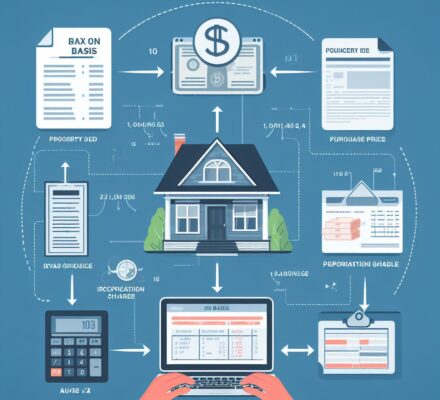Are you ready to unlock the door to tax savings?
In the world of 1031 exchanges, achieving optimal basis is the key to maximizing your financial gains.
This article will guide you through the intricacies of identifying like-kind properties, calculating your basis, and leveraging depreciation for maximum tax benefits.
With a comprehensive understanding of these strategies, you’ll be equipped to plan for the future and secure your financial success.
Get ready to open the door to substantial tax savings.
Key Takeaways
- 1031 exchanges defer capital gains taxes through property swaps.
- Like-kind exchanges allow deferral of taxes on capital gains.
- Identifying like-kind properties is crucial, with both properties being used for productive purposes.
- Maximizing basis through cost segregation and depreciation can help reduce tax liability.
Understanding the Basics of 1031 Exchanges
To fully grasp the fundamentals of 1031 exchanges, you need to familiarize yourself with the concept of deferring capital gains taxes through property swaps. A 1031 exchange, also known as a like-kind exchange, allows you to defer paying taxes on the capital gains from the sale of an investment property by reinvesting the proceeds into another like-kind property. This tax deferral strategy is based on the principle that by exchanging one investment property for another, you aren’t actually realizing a gain or loss, but rather transferring the investment from one property to another. The Internal Revenue Code Section 1031 provides the legal framework for these transactions.
In order to qualify for a 1031 exchange, both the relinquished property (the property being sold) and the replacement property (the property being acquired) must meet certain criteria. First and foremost, both properties must be held for investment or business purposes. Personal use properties, such as primary residences or vacation homes, don’t qualify. Additionally, the replacement property must be of equal or greater value than the relinquished property, and all the proceeds from the sale must be reinvested into the new property.
Identifying Qualifying Like-Kind Properties
How can you identify qualifying like-kind properties for a 1031 exchange? When it comes to a 1031 exchange, it is crucial to ensure that the replacement property being considered is of a like-kind to the relinquished property. This means that the properties must be similar in nature, regardless of their quality or grade. To help you navigate this process, consider the following table that outlines the key factors to consider when identifying qualifying like-kind properties:
| Factor | Explanation |
|---|---|
| Type of Property | The replacement property must be of the same nature or character as the relinquished property. For example, a commercial property can be exchanged for another commercial property. |
| Use of Property | Both the relinquished and replacement properties must be used for productive purposes, such as rental or investment, rather than personal use. |
| Timing | The identification of the replacement property must occur within 45 days of the sale of the relinquished property. |
| Value | The value of the replacement property must be equal to or greater than the value of the relinquished property to fully defer the capital gains tax. |
| Holding Period | The taxpayer must hold the replacement property for a minimum of two years to satisfy the requirements of a 1031 exchange. |
Calculating and Maximizing Your Basis
To calculate and maximize your basis in a 1031 exchange, it’s important to consider various factors discussed in the previous subtopic. The basis of a property is the value used to calculate taxable gain or loss upon its sale. In a 1031 exchange, the basis of the relinquished property is transferred to the replacement property. To calculate your basis in the replacement property, you need to add the cost of the replacement property to the basis of the relinquished property. The cost of the replacement property includes the purchase price, closing costs, and any expenses incurred to acquire the property.
Maximizing your basis is crucial because it can help reduce your tax liability. By increasing your basis, you can potentially lower your taxable gain when you sell the replacement property in the future. There are several ways to maximize your basis, such as conducting a cost segregation study to allocate a higher percentage of the purchase price to shorter-lived assets, which can be depreciated over a shorter period of time.
Leveraging Depreciation and Cost Segregation
By leveraging depreciation and cost segregation, you can further enhance your basis in a 1031 exchange and potentially achieve greater tax savings.
Depreciation is the gradual decrease in the value of an asset over time, and it allows you to deduct a portion of the asset’s cost each year. In a 1031 exchange, you can transfer the accumulated depreciation from your relinquished property to your replacement property, thereby increasing your basis in the replacement property. This higher basis can result in lower taxable gains when you eventually sell the replacement property.
Cost segregation is another strategy that can help you maximize your basis in a 1031 exchange. It involves identifying and classifying different components of a property, such as building systems and personal property, and assigning shorter recovery periods for tax purposes. By doing so, you can accelerate the depreciation deductions and increase your basis in the property.
To leverage depreciation and cost segregation effectively, it’s important to work with professionals who specialize in these areas. They can help you identify and properly allocate the costs of your property, ensuring that you’re maximizing your basis and taking full advantage of available tax benefits.
Planning for the Future: Exit Strategies and Estate Planning
When considering your future, it’s important to establish effective exit strategies and engage in comprehensive estate planning to ensure a smooth transition and maximum tax benefits. Proper planning can help you protect your assets, minimize tax liabilities, and ensure that your wishes are carried out after your passing.
Here are three key aspects to consider when developing your exit strategies and estate plan:
- Succession planning: Determine who’ll take over your business or assets when you retire or pass away. This involves identifying and preparing potential successors, implementing a smooth transition plan, and considering the tax implications of transferring ownership.
- Estate tax planning: Strategically plan your estate to minimize estate taxes and maximize the amount of wealth passed on to your beneficiaries. Utilize tools such as trusts, gifting strategies, and life insurance to protect your assets and reduce tax liabilities.
- Asset protection: Safeguard your assets from potential creditors, lawsuits, and other risks. Implement strategies such as asset protection trusts, limited liability companies (LLCs), and insurance policies to shield your wealth and ensure it’s preserved for future generations.
Frequently Asked Questions
What Are the Potential Tax Implications of a 1031 Exchange?
The potential tax implications of a 1031 exchange depend on various factors. You may be able to defer capital gains taxes by exchanging like-kind properties, but it’s important to consult a tax professional for specific guidance.
Can I Exchange a Residential Property for a Commercial Property in a 1031 Exchange?
Yes, you can exchange a residential property for a commercial property in a 1031 exchange. This allows you to defer taxes and potentially increase your basis, resulting in long-term tax savings.
Are There Any Restrictions on the Time Frame for Completing a 1031 Exchange?
There are restrictions on the time frame for completing a 1031 exchange. You must identify replacement property within 45 days and acquire it within 180 days. Failure to meet these deadlines can result in disqualification.
Can I Use a 1031 Exchange to Defer Taxes Indefinitely?
No, you cannot use a 1031 exchange to defer taxes indefinitely. While a 1031 exchange allows for tax deferral, there are rules and time limits in place that must be followed.
How Does the IRS Treat Boot in a 1031 Exchange?
The IRS treats boot in a 1031 exchange as taxable. Boot refers to cash or non-like-kind property received in the exchange. You must report the boot as gain and pay taxes on it.




